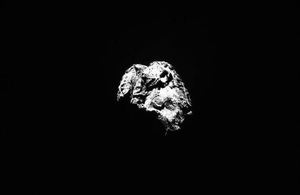Europe’s historic comet lander faces eternal hibernation
Silent since its last call to mothership Rosetta seven months ago, the Philae lander is facing conditions on Comet 67P/Churyumov–Gerasimenko from which it is unlikely to recover.

Comet 67P/Churyumov–Gerasimenko. [Credit: ESA/Rosetta/MPS for OSIRIS Team MPS/UPD/LAM/IAA/SSO/INTA/UPM/DASP/IDA]
Rosetta, which continues its scientific investigations at the comet until September before its own comet-landing finale, has in recent months been balancing science observations with flying dedicated trajectories optimised to listen out for Philae. But the lander has remained silent since 9 July 2015.
“The chances for Philae to contact our team at our lander control centre are unfortunately getting close to zero,” says Stephan Ulamec, Philae project manager at the German Aerospace Center, DLR. “We are not sending commands any more and it would be very surprising if we were to receive a signal again.”
Philae’s team of expert engineers and scientists at the German, French and Italian space centres and across Europe have carried out extensive investigations to try to understand the status of the lander, piecing together clues since it completed its first set of scientific activities after its historic landing on 12 November 2014.
A story with incredible twists and turns unfolded on that day. In addition to a faulty thruster, Philae also failed to fire its harpoons and lock itself onto the surface of the comet after its seven-hour descent, bouncing from its initial touchdown point at Agilkia, to a new landing site, Abydos, over 1 km away. The precise location of the lander has yet to be confirmed in high-resolution images.
Even after this unplanned excursion, the lander was still able to make an impressive array of science measurements, with some even as it was flying above the surface after the first bounce.
In the 64 hours following its separation from Rosetta, Philae took detailed images of the comet from above and on the surface, sniffed out organic compounds, and profiled the local environment and surface properties of the comet, providing revolutionary insights into this fascinating world.
Subsequent analysis of the data indicated that the lander had in fact already woken up on 26 April 2015, but had been unable to send any signals until 13 June.
After 13 June, Philae made a further seven intermittent contacts with Rosetta in the following weeks, with the last coming on 9 July. However, the communications links that were established were too short and unstable to enable any scientific measurements to be commanded.
Despite the improved thermal conditions, with temperatures inside Philae reaching 0ºC, no further contacts were made as the comet approached perihelion in August.
The mission engineers think that failures of Philae’s transmitters and receivers are the most likely explanation for the irregular contacts last year, followed by continued silence into this year.
Another difficulty that Philae may be facing is dust covering its solar panels, ejected by the comet during the active perihelion months, preventing the lander from powering up. Also, the attitude and even location of Philae may have changed since November 2014 owing to cometary activity, meaning that the direction in which its antenna is sending signals to Rosetta is not as predicted, affecting the expected communication window.
Rosetta, Philae and the comet are now heading back out towards the outer Solar System again. They have crossed the orbit of Mars and are now some 350 million km from the Sun. According to predictions, the temperatures should be falling far below those at which Philae is expected to be able to operate. Nevertheless, while hopes of making contact again with Philae dwindle, Rosetta will continue to listen for signals from the lander as it flies alongside the comet ahead of its own comet landing in September.
Rosetta and the UK
With funding from the UK Space Agency and the Science and Technology Facilities Council (STFC), Rosetta is a mission with significant UK involvement from industry and science.
Visit our Rosetta mission page to find out more